Parameterised Model of 2D Combustor Exit Flow Conditions for High-Pressure Turbine Simulations †
Abstract
:1. Introduction
1.1. Background
1.2. Scope and Content of This Paper
2. Method
2.1. Overall Parameterisation Strategy
2.2. Axial Velocity
2.3. In-Plane Velocity Field
2.3.1. Swirl Velocity Field
2.3.2. End Wall Inclination
2.3.3. Flow Entrainment
2.4. Pressure
2.5. Temperature
2.5.1. Baseline Profile
2.5.2. Hot Spots
2.5.3. Overall Profile
2.6. Turbulence
3. Validation
3.1. Matching a Target Interface
3.2. CFD Setup
3.3. Results
3.3.1. Stage Efficiency
3.3.2. Heat Transfer and Wall Temperatures
4. Conclusions
Acknowledgments
Author Contributions
Conflicts of Interest
Abbreviations
| Latin | |
| A | area |
| coefficients | |
| weighting factor | |
| NGV pressure loss coefficient | |
| c | true chord length |
| heat capacity at constant pressure | |
| d | swirl direction |
| D | diameter |
| function | |
| adiabatic heat transfer coefficient | |
| K | number of parameters for optimization |
| k | turbulent kinetic energy |
| L | turbulent length scale |
| mass flow | |
| N | number of hot spots |
| true chord based Nusselt number | |
| p | pressure |
| r | radial coordiante w.r.t. machine axis |
| R | radial coordiante w.r.t. swirl centre |
| S | swirl number |
| T | temperature |
| turbulence intensity | |
| V | velocity |
| y | objective of optimization |
| non-dimensional wall distance | |
| Greek | |
| flow angle | |
| ratio of specific heats | |
| circulation | |
| infinite difference | |
| finite difference | |
| positioning parameter | |
| isentropic efficiency | |
| circumferential coordinate/angle | |
| averaging weight | |
| density | |
| hot spot scaling factor | |
| hot spot rotation angle | |
| generic flow quantity | |
| shaping parameter | |
| specific turbulent dissipation rate | |
| Subscripts | |
| axial | |
| design point | |
| hub | |
| inlet | |
| isentropic | |
| hot streak | |
| mirrored | |
| maximum | |
| minimum | |
| outlet | |
| shroud | |
| swirl | |
| scaling | |
| radial | |
| total/stagnation | |
| circumferential | |
| Superscripts | |
| mean | |
| * | normalised quantity |
| temperature baseline field | |
| end wall inclination | |
| hot spot index | |
| NGV domain | |
| parameterised field | |
| reference field | |
| swirl field | |
| flow entrainment | |
| temperature boundary layer | |
| Abbreviations | |
| BC | boundary condition |
| CTI | combustor turbine interaction |
| CFD | computational fluid dynamics |
| HPT | high pressure turbine |
| LSTR | Large Scale Turbine Rig |
| LES | large eddy simulation |
| NGV | nozzle guide vane |
| RANS | Reynolds-averaged Navier–Stokes |
| RRD | Rolls-Royce Deutschland Ltd. & Co. KG |
| RTDF | radial temperature distortion factor |
Appendix A. Modelling of Flow Entrainment

Appendix A.1. Entrained Flow from the Hub—Radial Component
Appendix A.2. Entrained Flow from the Hub—Circumferential Component

Appendix B. Matching of Additional Target Interfaces
Appendix B.1. Lean Burn Test Cases
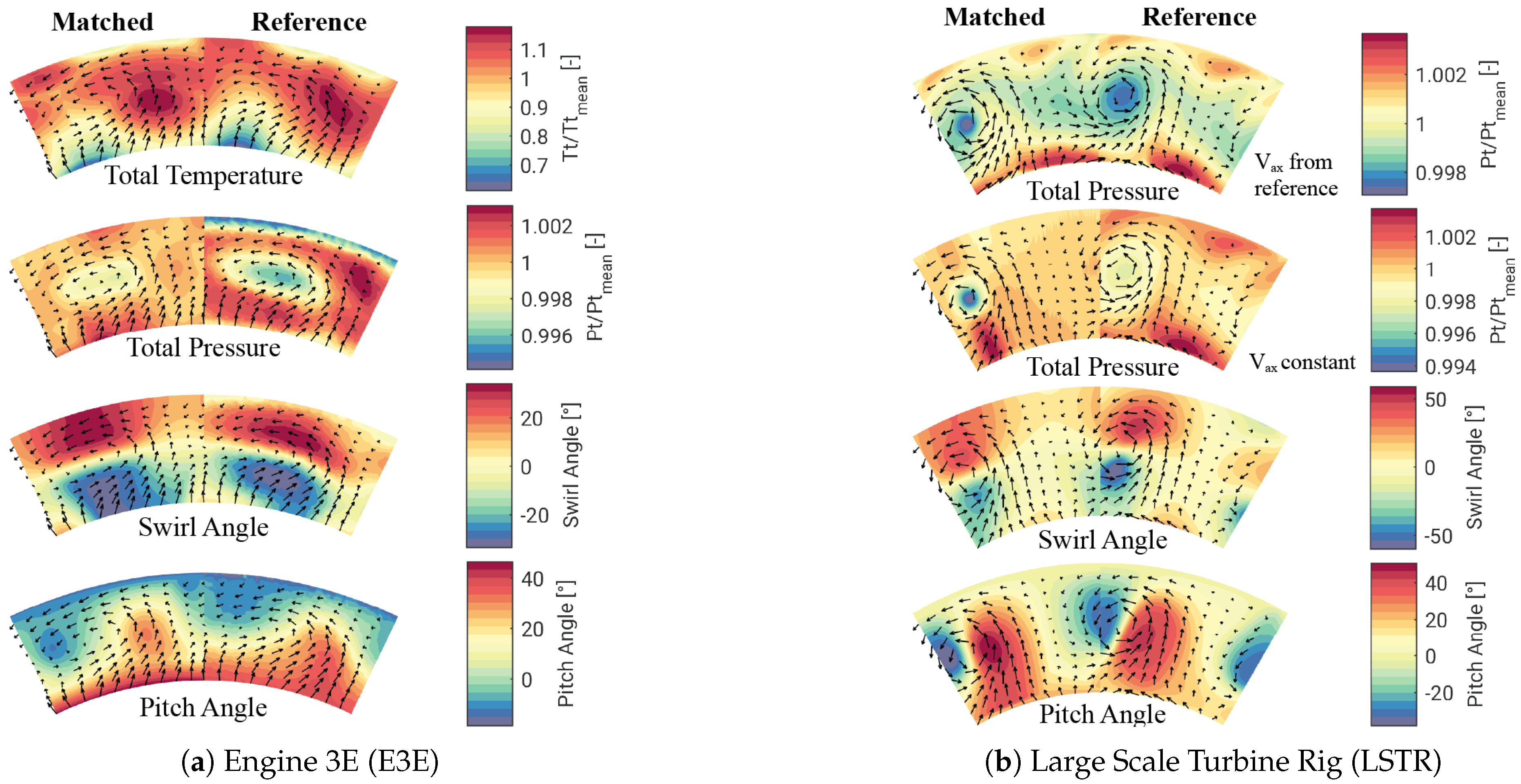
Appendix B.2. Rich Burn Test Cases
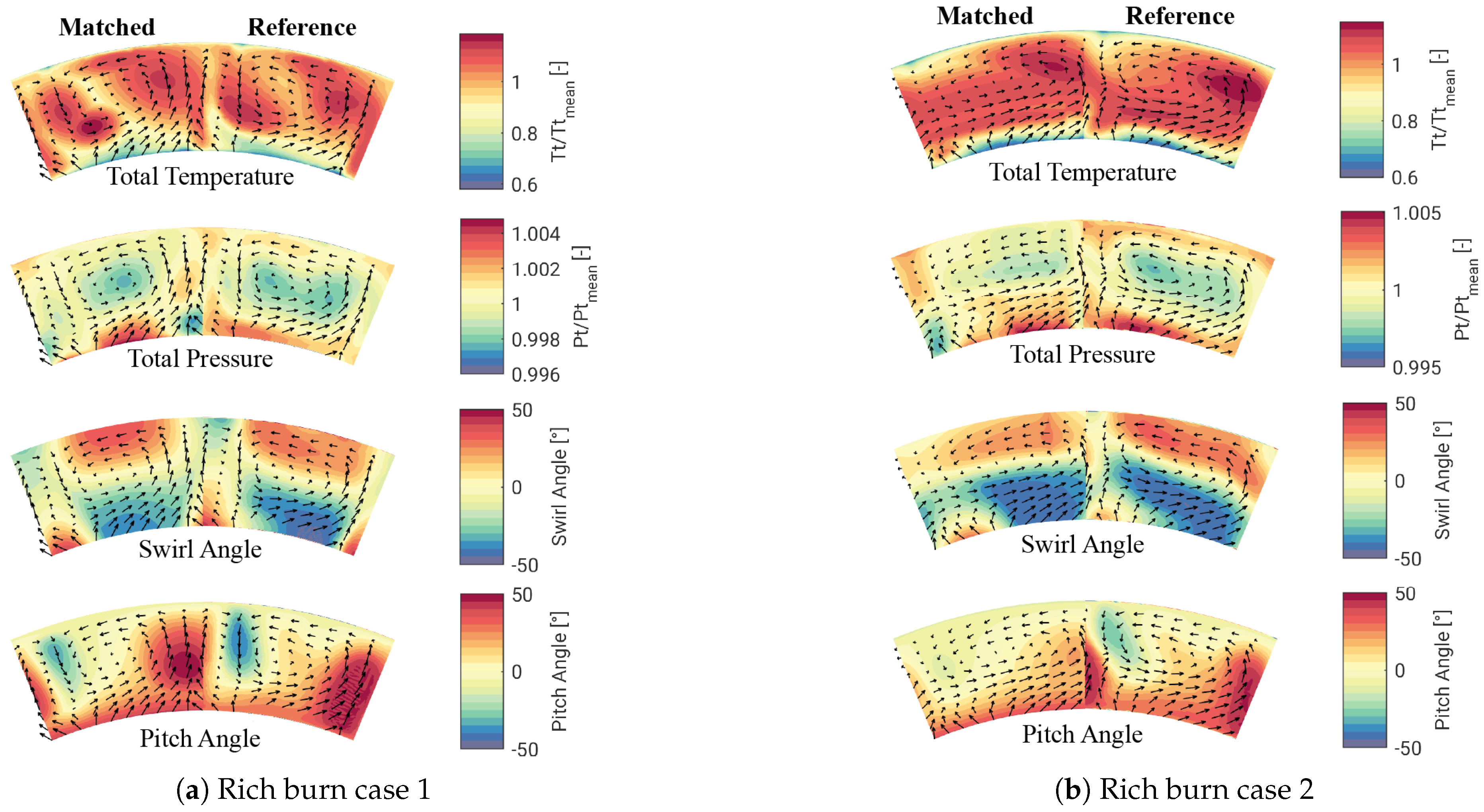
Appendix C. Influence of Inlet Turbulence Distribution

References
- Klapdor, E.V. Simulation of Combustor-Turbine Interaction in a Jet Engine. Ph.D. Thesis, TU Darmstadt, Darmstadt, Germany, 2011. [Google Scholar]
- Chana, K.; Cardwell, D.; Jones, T. A Review of the Oxford Turbine Research Facility. In Proceedings of the ASME Turbo Expo 2013: Turbine Technical Conference and Exposition, San Antonio, TX, USA, 3–7 June 2013; p. GT2013-95687. [Google Scholar]
- Povey, T.; Qureshi, I. Developments in hot streak simulators for turbine testing. ASME J. Turbomach. 2009, 121, 031009. [Google Scholar] [CrossRef]
- Krichbaum, A.; Werschnik, H.; Wilhelm, M.; Schiffer, H.P.; Lehmann, K. A Large Scale Turbine Test Rig for the Investigation of High Pressure Turbine Aerodynamics and Heat Transfer with variable Inflow Conditions. In Proceedings of the ASME Turbo Expo 2015: Turbine Technical Conference and Exposition, Montreal, QC, Canada, 15–19 June 2015; p. GT2015-43261. [Google Scholar]
- Cha, C.M.; Hong, S.; Ireland, P.T.; Denman, P.; Savarianandam, V. Experimental and Numerical Investigation of Combustor-Turbine Interaction Using an Isothermal, Nonreacting Tracer. J. Eng. Gas Turb. Power 2016, 134, 081501. [Google Scholar] [CrossRef]
- Hall, B.F.; Chana, K.S.; Povey, T. Design of a Nonreacting Combustor Simulator With Swirl and Temperature Distortion With Experimental Validation. J. Eng. Gas Turb. Power 2014, 136, 081501. [Google Scholar] [CrossRef]
- Vagnoli, S.; Verstraete, T. Numerical Study of the Combustor-Turbine Interaction Using Coupled Unsteady Solvers. In Proceedings of the 22nd International Association of Air Breathing Engines (ISABE), Phoenix, Az, USA, 25–30 October 2015. [Google Scholar]
- Raynaud, F.; Eggels, R.L.G.M.; Staufer, M.; Sadiki, A.; Janicka, J. Towards Unsteady Simulation of Combustor-Turbine Interaction Using an Integrated Approach. In Proceedings of the ASME Turbo Expo 2015: Turbine Technical Conference and Exposition, Montreal, QC, Canada, 15–19 June 2015; p. GT2015-42110. [Google Scholar]
- Koupper, C.; Bonneau, G.; Gicquel, L.; Duchaine, F. Large Eddy Simulations of the Combustor Turbine Interface: Study of the Potential and Clocking Effects. In Proceedings of the ASME Turbo Expo 2016: Turbomachinery Technical Conference and Exposition, Seoul, Korea, 13–17 June 2016; p. GT2016-56443. [Google Scholar]
- Munk, M.; Prim, R. On the Multiplicity of Steady Gas Flows Having the Same Streamline Pattern. Proc. Natl. Acad. Sci. USA 1947, 33, 1–8. [Google Scholar] [CrossRef]
- Kerrebrock, J.L.; Mikolajczak, A.A. Intra-Stator Transport of Rotor Wakes and Its Effects on Compressor Performance. ASME J. Energy Power 1970, 92, 359–368. [Google Scholar] [CrossRef]
- Ong, J.; Miller, R.J. Hot Streak and Vane Coolant Migration in a Downstream Rotor. ASME J. Turbomach. 2012, 134, 051002. [Google Scholar] [CrossRef]
- Tallman, J.A. Unsteady Half-Annulus Computational Fluid Dynamics Calculations of Thermal Migration Through a Cooled 2.5 Stage High-Pressure Turbine. ASME J. Turbomach. 2014, 136, 081012. [Google Scholar] [CrossRef]
- Giller, L.; Schiffer, H.P. Interactions Between the Combustor Swirl and the High Pressure Stator of a Turbine. In Proceedings of the ASME Turbo Expo 2012: Turbine Technical Conference and Exposition, Copenhagen, Denmark, 11–15 June 2012; p. GT2012-69157. [Google Scholar]
- Qureshi, I.; Smith, A.D.; Povey, T. HP Vane Aerodynamics and Heat Transfer in the Presence of Aggressive Inlet Swirl. ASME J. Turbomach. 2013, 135, 021040. [Google Scholar] [CrossRef]
- Schmid, G. Effects of Combustor Exit Flow an Turbine Performance and Heat Transfer. Ph.D. Thesis, TU Darmstadt, Darmstadt, Germany, 2014. [Google Scholar]
- Beard, P.F.; Smith, A.D.; Povey, T. Effect of Combustor Swirl on Transonic High Pressure Turbine Efficiency. ASME J. Turbomach. 2014, 136, 011002. [Google Scholar] [CrossRef]
- Insinna, M.; Griffini, D.; Salvadori, S.; Martelli, F. Effect of Realistic Inflow Conditions an the Aero-Thermal Performance of a Film-Cooled Vane. In Proceedings of the 11th European Turbomachinery Conference, Jyvaskyla, Finland, 25–27 May 2015. [Google Scholar]
- Jacobi, S.; Mazzoni, C.; Chana, K.; Rosic, B. Investigation of Unsteady Flow Phenomena in First Vane Caused by Combustor Flow with Swirl. In Proceedings of the ASME Turbo Expo 2016: Turbomachinery Technical Conference and Exposition, Seoul, Korea, 13–17 June 2016; p. GT2016-57358. [Google Scholar]
- He, L.; Haller, B.R. Influence of Hot Streak Circumferential Length-Scale in Transonic Turbine Stage. In Proceedings of the ASME Turbo Expo 2004: Power for Land, Sea, and Air, Vienna, Austria, 14–17 June 2004; p. GT2004-53370. [Google Scholar]
- Basol, A.M.; Jenny, P.; Ibrahim, M.; Kalfas, A.I.; Abhari, R.S. Hot Streak Migration in a Turbine Stage: Integrated Design to Improve Aerothermal Performance. J. Eng. Gas Turb. Power 2011, 133, 061901. [Google Scholar] [CrossRef]
- Beard, P.F.; Smith, A.; Povey, T. Impact of Severe Temperature Distortion on Turbine Efficiency. ASME J. Turbomach. 2013, 135, 011018. [Google Scholar] [CrossRef]
- Fossen, G.J.V.; Bunker, R.S. Augmentation of Stagnation Region Heat Transfer Due to Turbulence from a DLN Can Combustor. ASME J. Turbomach. 2001, 123, 140–146. [Google Scholar] [CrossRef]
- Khanal, B.; He, L.; Northall, J.; Adami, P. Analysis of Radial Migration of Hot-Streak in Swirling Flow Through High-Pressure Turbine Stage. ASME J. Turbomach. 2013, 135, 041005. [Google Scholar] [CrossRef]
- CFX5. Solver Theory Guide. Release 17.0; ANSYS: Canonsburg, PA, USA, 2016. [Google Scholar]
- Gupta, A.K.; Lilley, D.G. Swirl Flows; Abacus Press: Tunbridge Wells, UK, 1985. [Google Scholar]
- MATLAB. Global Optimization Toolbox User’s Guide; The Math Works: Natick, MA, USA, 2016. [Google Scholar]
- Menter, F.R. Two-Equation Eddy-Viscosity Turbulence Models for Engineering Applications. AIAA J. 1994, 32, 1598–1605. [Google Scholar] [CrossRef]
- Klinger, H.; Lazik, W.; Wunderlich, T. The Engine 3E Core Engine. In Proceedings of the ASME Turbo Expo 2008: Power for Land, Sea, and Air, Berlin, Germany, 9–13 June 2008; p. GT2008-50679. [Google Scholar]
- Hilgert, J.; Bruschewski, M.; Werschnik, H.; Schiffer, H.P. Numerical Studies on Combustor-Turbine Interaction at the Large Scale Turbine Rig (LSTR). In Proceedings of the ASME Turbo Expo 2017: Turbomachinery Technical Conference and Exposition, Charlotte, NC, USA, 16–30 June 2017; p. GT2017-64504. [Google Scholar]


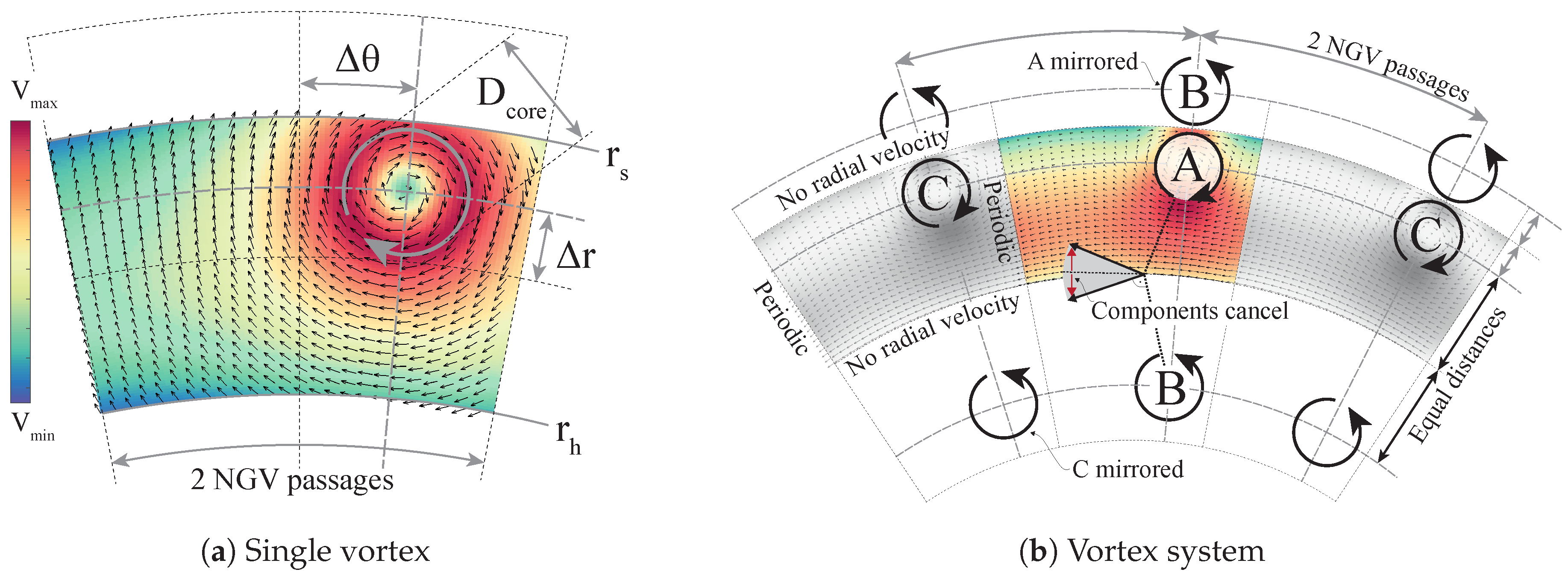




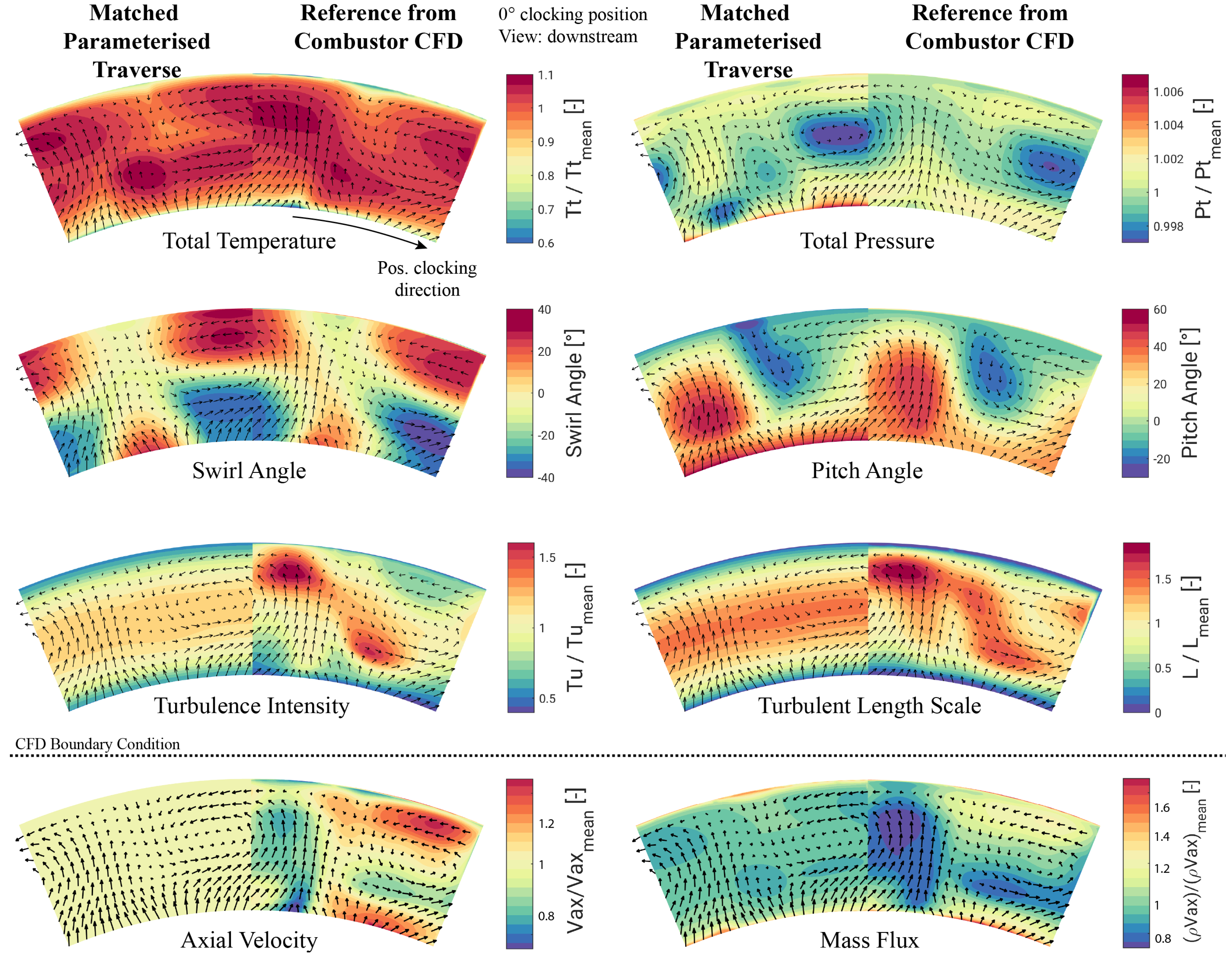
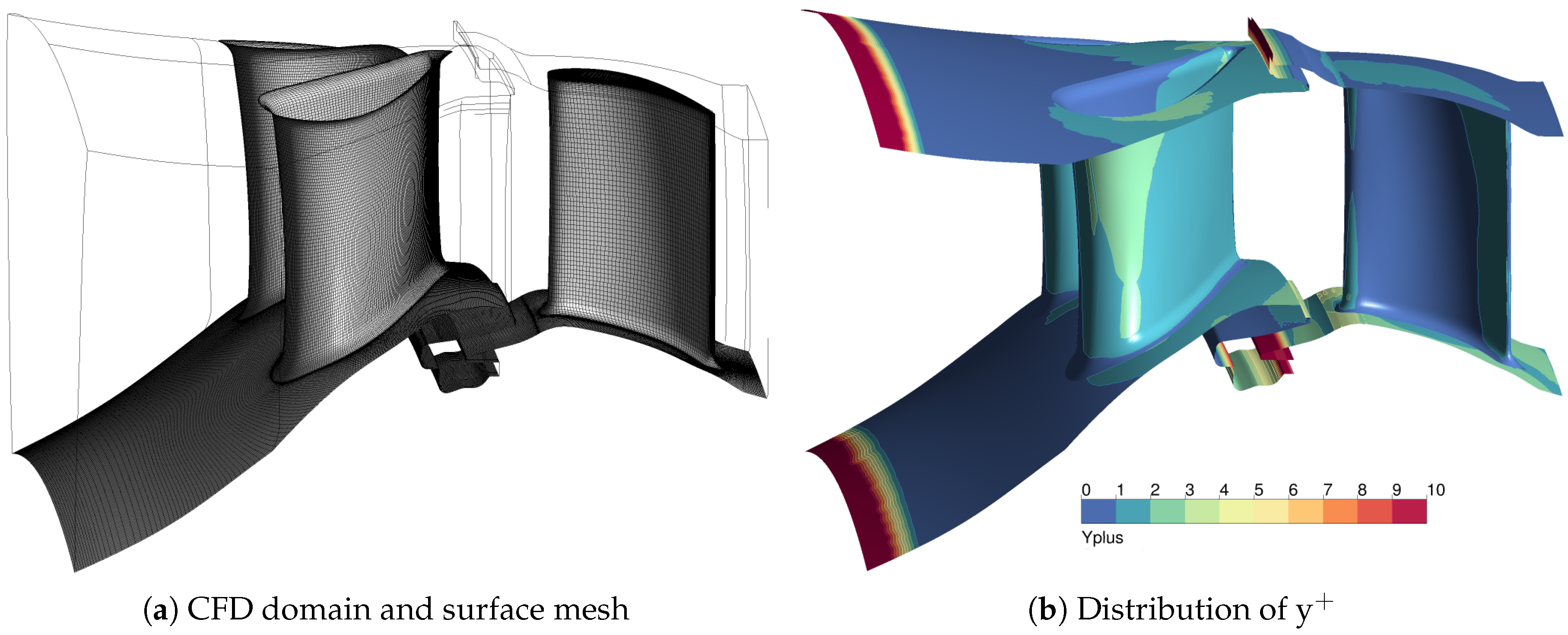


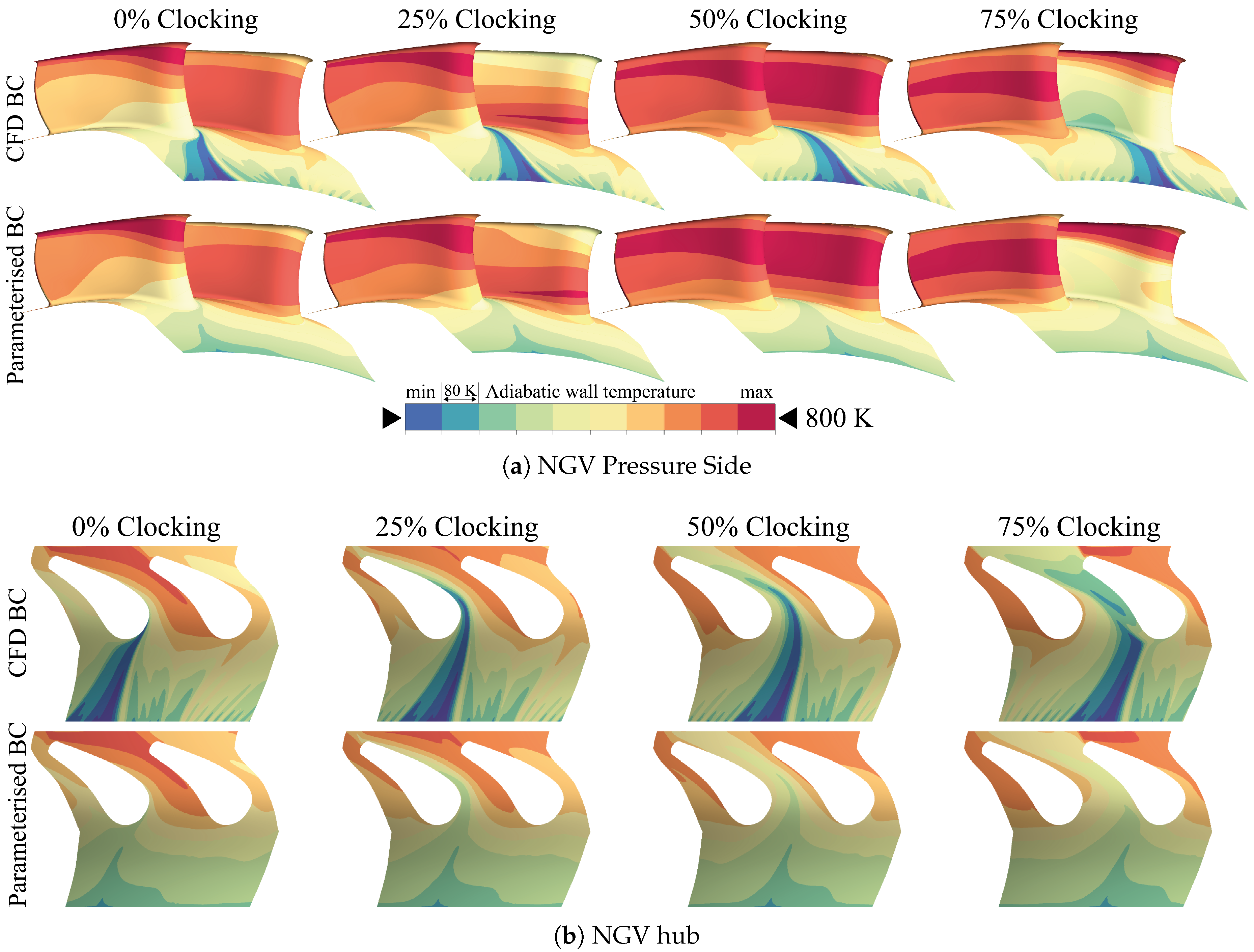


| Number of | Number of | y | Minimal | Maximal | ||
|---|---|---|---|---|---|---|
| Passages | Elements | Maximum | Average | Angles | Aspect Ratio | |
| Stator | 2 | 3.757 Mio. | 53.06 | 1.75 | 17.1 | 384 |
| Rotor | 1 | 2.417 Mio. | 26.07 | 2.20 | 15.0 | 504 |
© 2017 by the authors. Licensee MDPI, Basel, Switzerland. This article is an open access article distributed under the terms and conditions of the Creative Commons Attribution (CC BY-NC-ND) license (https://creativecommons.org/licenses/by-nc-nd/4.0/).
Share and Cite
Schneider, M.; Schiffer, H.-P.; Lehmann, K. Parameterised Model of 2D Combustor Exit Flow Conditions for High-Pressure Turbine Simulations. Int. J. Turbomach. Propuls. Power 2017, 2, 20. https://doi.org/10.3390/ijtpp2040020
Schneider M, Schiffer H-P, Lehmann K. Parameterised Model of 2D Combustor Exit Flow Conditions for High-Pressure Turbine Simulations. International Journal of Turbomachinery, Propulsion and Power. 2017; 2(4):20. https://doi.org/10.3390/ijtpp2040020
Chicago/Turabian StyleSchneider, Marius, Heinz-Peter Schiffer, and Knut Lehmann. 2017. "Parameterised Model of 2D Combustor Exit Flow Conditions for High-Pressure Turbine Simulations" International Journal of Turbomachinery, Propulsion and Power 2, no. 4: 20. https://doi.org/10.3390/ijtpp2040020
APA StyleSchneider, M., Schiffer, H.-P., & Lehmann, K. (2017). Parameterised Model of 2D Combustor Exit Flow Conditions for High-Pressure Turbine Simulations. International Journal of Turbomachinery, Propulsion and Power, 2(4), 20. https://doi.org/10.3390/ijtpp2040020





